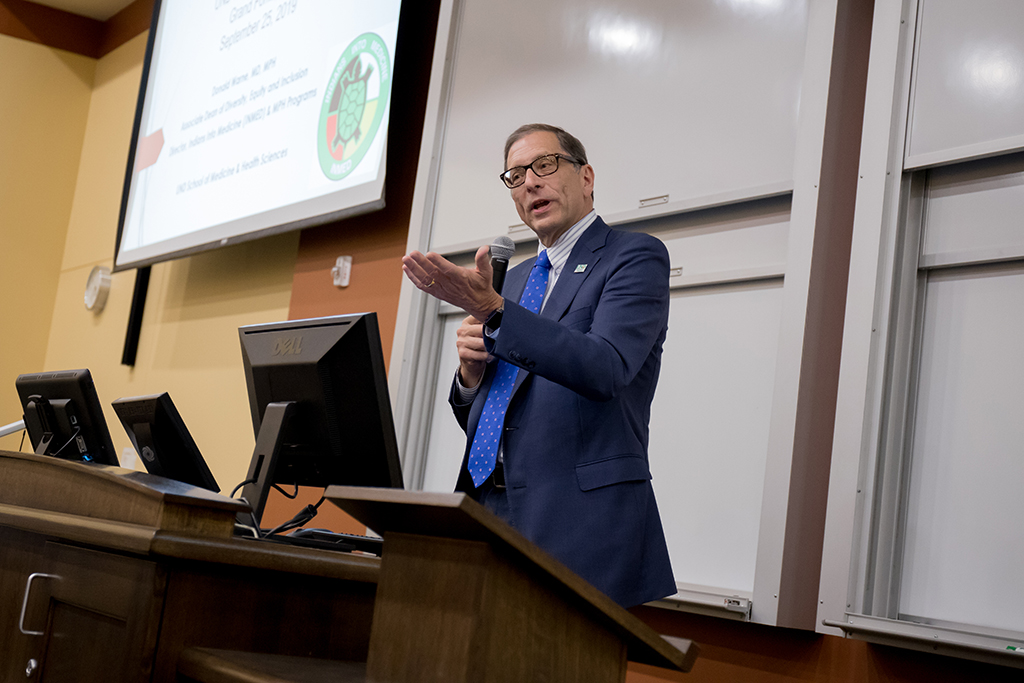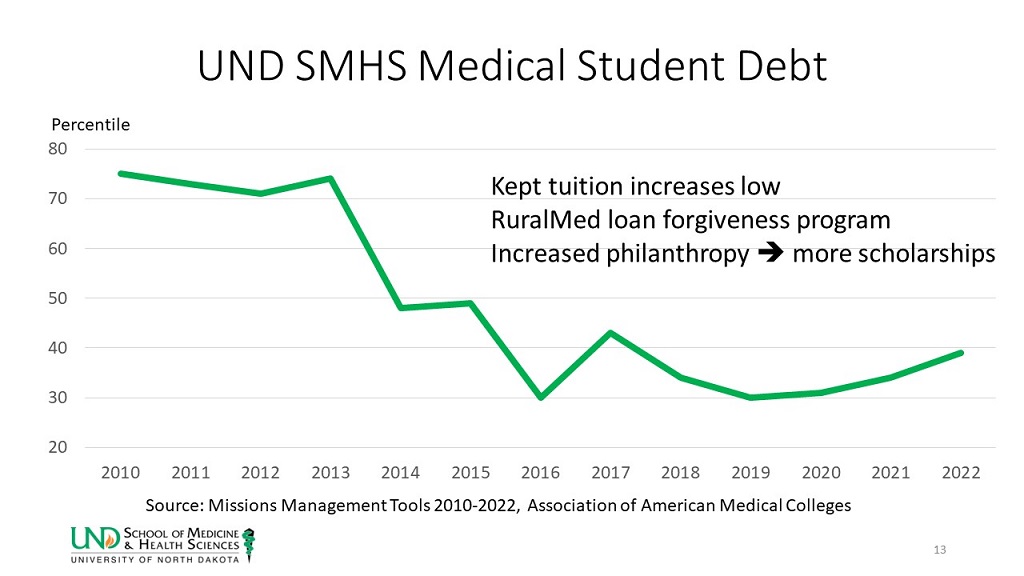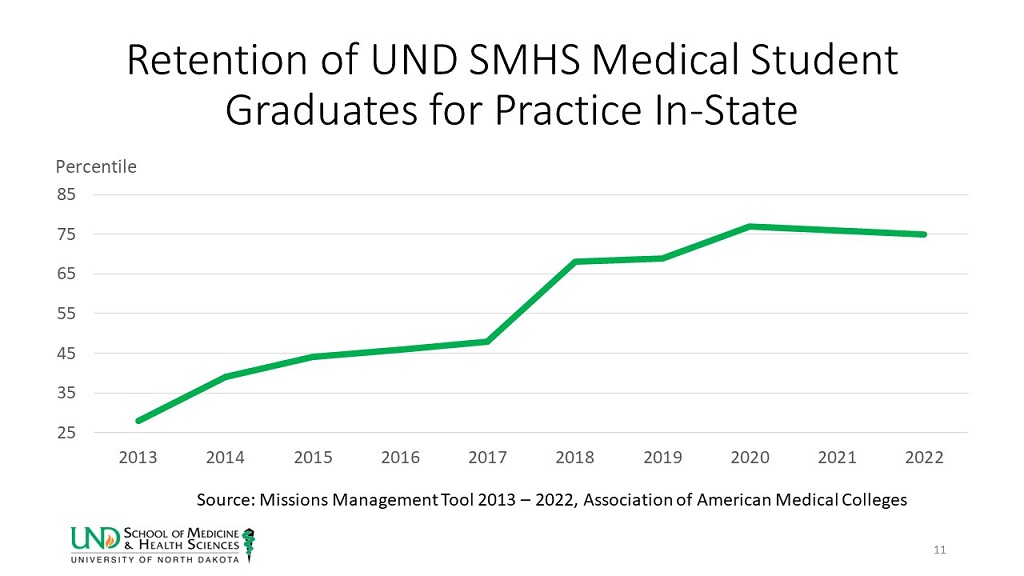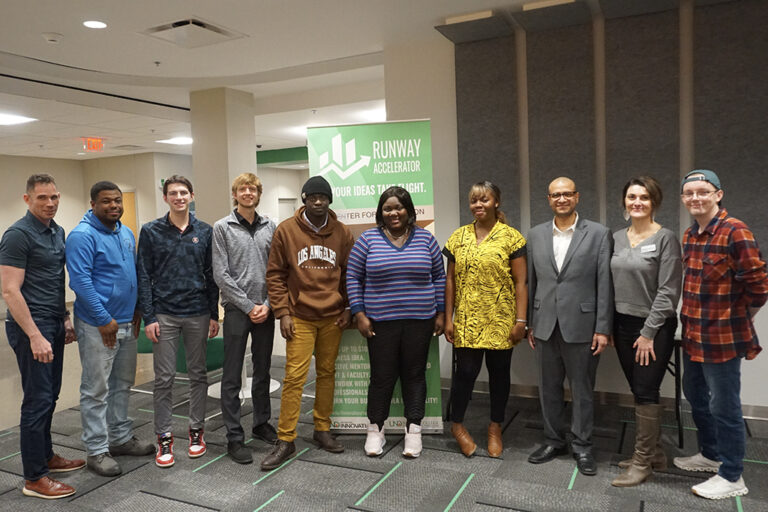UND drove down its medical students’ median debt
And all North Dakota benefits as a result, explains Dr. Joshua Wynne, dean of the UND School of Medicine & Health Sciences

Editor’s note: Among the strategic initiatives listed under the “Equity” core value of the UND Strategic Plan is the following: “Reduce barriers to higher education by increasing affordability through scholarships, need-based aid, and Open Educational Resources.”
And with that in mind, we proudly present this Q&A that we first published back in August, in which UND Vice President and Dean Dr. Joshua Wynne explains how the School of Medicine & Health Sciences is doing just that.
****
As the UND School of Medicine & Health Sciences welcomed its medical doctor Class of 2027 this summer, Dr. Joshua Wynne knew from experience that something was likely weighing on new students’ minds.
That’s why, during the School’s Family Day event, Wynne addressed the topic of student debt head-on for students and their family members.
His recent column in the SMHS “For Your Health” newsletter briefly reflected on this moment, including the following quote:
“As I’ve mentioned before, we’ve been successful in driving down the median debt of our students from well above the national average to well below. For the last full academic year (2023), we were at the 29th percentile, meaning that the debt of our medical students is lower than that of almost three-quarters of the med students at other schools.”
These data, derived from the latest annual report from the Association of American Medical Colleges, of which UND is a member institution, mark a significant and positive change from a decade ago when UND medical students’ debt load was around the 75th percentile. The AAMC represents 170 accredited U.S. and Canadian medical schools.
How has this change at UND come about? What effect does student debt have when educating the next generation of doctors and health care workers? How does the SMHS balance costs and quality of education?
UND Today recently hosted an interview with Wynne, who serves both as vice president for health affairs and dean of SMHS, to get his take on these questions and more.
The following Q&A has been condensed and edited for style and clarity.
UND Today: I’m hoping to talk to you about this subject from, perhaps obviously, a leadership perspective. During my time at UND, I’ve come to recognize that you have an interest in mitigating these financial burdens for students. And one example I thought of in reading that quote was when you were serving as interim president. During the Memorial Union project, you really made an effort to make that project not have as big of an impact on tuition. So, looking at a couple of these examples, and the way you wrote about talking to students, engaging them on the topic, it stood out to me that this is something of importance to you.
Can I just start by asking about your relationship to this specific aspect of higher education? What has brought you professionally to have concern for financial burden for students?
Wynne: It’s a combination of personal experience and intellectual assessment. I grew up and went to college very much dependent on my own resources. My family didn’t have a huge amount to contribute. So, it made me aware, sensitive to what was the plight – I think it’s a fair word – of many students, where mom and dad just can’t write the check to go to college. And I’m a firm believer that we need to have equal opportunities for people so they can maximize whatever inherent abilities they have. But what we’ve seen, though, is that debt burden can influence subsequent behavior, career choices, where students choose to locate and so forth, after they graduate. That’s the intellectual part. The personal part was being there and experiencing it.
The second part was the observation that debt, especially for medical students, is high on their list of concerns. Now, what we don’t know with full certainty is how that concern directly impacts decisions they make. But the data I quoted certainly support the hypothesis that positively influencing debt can positively influence subsequent career choices.
So, let me just go over the data you quoted to show you, in verbal terms, two charts that have occurred roughly at the same time. The first chart is the one you talked about, which is that over a decade or a decade and a half, we have been able to reduce the median debt of our medical students, from well above the national average down to well below.

In other words, we were running at the 75th percentile, meaning that our students had debt equal to or greater than three quarters of medical students in the United States. We were at the high level; that is, only a quarter had lower debt. And over that 10 or 15 years, we reduced it down to what you quoted, down below the 30th percentile, meaning the majority of medical students in the United States have more debt.
Chart number two looks at the retention of medical students, once they graduate, for practice in the state of North Dakota. Now, there is some time delay in this – you have to do residency training and so forth. But what we’ve seen over roughly the same time period is that UND has gone from well below the national average for retaining students within the state for practice to well above the national average, in round numbers, going from around the 25th percentile up to around the 75th percentile.

That doesn’t prove that there’s a causal relationship; I will acknowledge that. But the implication is pretty robust that by focusing on student debt, and actually reducing it, that has had a positive influence on our ability to keep students within state for clinical practice.
So, what are our goals with this? Well, we want to keep our graduates in-state, we want them to focus as much as possible on primary care (family medicine and pediatrics). And we especially want them to practice in rural areas.
I would say, arguably, that all three of those could logically be tied to the amount of debt a student has. If you have a lot of debt, I would think it would be logical for students to say, “Well, I’m going to go out of state to a big city and find a high salary position so that I can pay off my debt,” or, “I’m going to go into a specialty other than family medicine, because it’s more lucrative,” or “I’m going to stay in a more urban area, rather than a rural area, because clearly the income potential in more rural areas is not the same as in a large urban area.”
Going back to your original question, I think working to reduce student debt is the right thing to do, not just because it feels right to me, but also, from an analytical standpoint, it really supports the mission of the School, which is to produce health care providers for the state of North Dakota – focusing on primary care and trying to ensure, as much as possible, that folks in rural areas get the same excellent care they can get in urban areas. And the data support that.
Is it proof? No. But, certainly, both trends are in the right direction, that we have reduced student debt substantially and we’ve improved retention – at least of medical students, but we don’t think that should be unique to medical students – for practice within the state.
UND Today: What has the School of Medicine & Health Sciences done in the recent past to help bring those changes about? Which efforts have directly affected this?
Wynne: I think there are three major things that we’ve been able to do.
Number one, we have worked hard to keep our tuition increases, especially for in-state students, to below what our colleagues around the country are doing, especially in the immediate area. So, our cost to attend has always been lower than our comparators. But it’s even lower now.
So, over roughly the same 10 or 15 years, we’ve gone from the 30th percentile in cost down to below the 10th percentile. When we have meetings to discuss what kind of tuition increase we’re going to request from the State Board of Higher Education and the Legislature, I think I’ve been a consistent voice for trying to keep the tuition increases as low as possible.
By keeping tuition increases low, and, quite frankly, by running a tight ship, financially, we have kept the cost to the students low. And obviously one of the reasons we’ve been able to do that is because of the generous support from the state. That has been an important component of it.
The second thing that we’ve done is to institute programs like – this is probably the most significant one – our RuralMed Program. This is a program where medical students, who agree to practice in a rural area of North Dakota for five years after they complete their training, have their medical school costs totally abrogated by the state of North Dakota through the School of Medicine & Health Sciences.
That has had, I think, a material impact in helping students who want to practice rural medicine be able to do it. I don’t want a medical student to go to Hettinger, N.D., just to be able to get out of their student debt. Rather, I want to eliminate a barrier that might prevent that student from practicing there because they’re saddled with debt.
So, let’s say a student goes to Hettinger, just to use it as an example, and changes their mind. We let them get out of the RuralMed agreement. They have to pay back the money, of course; it’s not forgiven if they don’t practice for the five years. But, we don’t want them to stay there unless that’s something they really want to do. And it’s been successful in that regard.
The third big thing that we’ve done is we’ve really made scholarship support our major ask from our very generous donors. We have worked hard to work with our donors to increase scholarship support for medical and other students. That also obviously reduces their debt.
So, I think those three things, keeping costs down, RuralMed and similar programs, and increasing scholarships support, have been the intentional mechanisms for mitigating student debt.
UND Today: Without routinely and significantly increasing tuition, how do you maintain the School’s quality of medical education?
Wynne: The reason we’ve been able to keep tuition increases limited while keeping the high quality of our education is that we have been able to buffer, if you will, the lost income from tuition that we might have otherwise gained. We’ve been able to supplement it by other sources, including the state of North Dakota, and that has let us continue to offer the high level of education that we provide to our students, so we don’t have to cut corners on educational expenses.
We’ve kept up our growth in our programs, but it’s made possible by things like the strong support from the state, income that we get from other sources (including our clinical practice plan) and relationships with hospitals. Also, philanthropic support doesn’t go just for scholarships, but it goes for other things such as endowed chairs. If we get money that goes to a faculty member’s salary, that frees up salary dollars that we can use in other ways.
So, it’s not like we’ve reduced tuition income and had to reduce our total budget. In fact, our budget has grown, but it’s grown disproportionately in those other areas so that our programs remain strong. Our financial underpinning remains strong, but it’s less of a reliance on tuition, though not a reduction in our programmatic support. We’ve just developed other sources to make up for what we otherwise would have gotten from tuition.
UND Today: How has this issue, as you’ve progressed in your career, changed your outlook on leadership and stewardship, especially considering the context of UND housing the state’s only medical school?
Wynne: When I first came here, and when I started talking to the students, trying to understand the unique role that the UND School of Medicine & Health Sciences played and why they came here, the most common answer was “The reason I really like the UND School of Medicine & Health Sciences is because I get a great education at a low price.” So, that’s the true definition of value, that is, high quality and relatively low cost.
And I have taken that advice or that view of things seriously, and have tried to work on both ends of that scale, of trying to keep our academic programs the very best we possibly can and keep the cost as low as possible so that the value proposition for the students is maximized – the best education at the least cost.
As your earlier question pointed out, we don’t want to say the least cost, meaning that we’re skimping on programs. It’s important, as I’ve outlined, that we try to maximize the educational experiences while minimizing the negative financial impact on the students. But you have to do both. You can’t do one or the other.
So, we try to do both, and sometimes we stumble, but that is the result of trying to do that dual mission of maximizing the experience and minimizing the cost.
UND Today: Looking into the future of the School of Medicine & Health Sciences, what are your aspirations for further addressing student debt? What areas are of interest to you and your leadership team?
Wynne: One of the things we continue to do is to remind our donors of the importance of scholarships, because even though we’re mitigating or limiting the amount of cost increase over time, costs will go up. You and I are both impacted by inflation; costs are going up. We want to just try to mitigate the amount of rise of that debt. So, one of the things we do is remind our donors of the importance of it.
But, we’ve also expanded our plea to donors to actually include not only scholarships, but also endowed positions, as I mentioned – endowed chairs, endowed professorships, endowed lectureships. This is to try to recruit and retain the very best faculty that will have a material impact on keeping that educational experience high.
One of the things I’ve been talking about and I see as a major challenge going forward is the following: the supply chain challenges are not just for ketchup in the grocery store; it’s for people. We have seen that over the past few years, the competition for talent has gotten even more intense.
As a small school, in a small state, at least by population, the way we can get an advantage in our competition for talent is to offer unique opportunities, particularly for faculty to come here. One of the ways we do that is with endowed positions. I had a discussion earlier today with a candidate we’re trying to recruit. I will tell you with some confidence that I don’t think we would be having that conversation if we didn’t have an endowed chair that we’re including as part of the discussion.
Going forward, I want to see the school develop even more endowed positions, where a donation is used in perpetuity to support that particular position. If we want to remain competitive on delivering a high-quality education, we need high quality educators. We need to look for things that give us a competitive advantage, and educators are part of that.
UND Today: What are you saying to new students or prospective students when it comes to what they’re about to take on financially?
Wynne: What I say is, keep your eye on the prize and look at the big picture. I’ve been practicing medicine for many decades, and I still see patients. Last week, I saw patients in the clinic Thursday and Friday. It is the most rewarding thing I’ve ever done in my life. As much as I like being a dean of a School of Medicine & Health Sciences, there is something incredibly fulfilling about trying to help a patient in a moment of need.
So, what I try to tell them is to not focus on the debt, and to trust us that we’re working with students to mitigate the debt. What you need to look at is the big picture, which is you’re going to become a physician or other health care provider, which is remarkably fulfilling and enjoyable.
Fulfilling is the right word, in that you’ve made a difference in someone else’s life. That’s not the same as helping a company make a lot of money. That’s a great thing. I’m not denigrating that. But there is something unique to help a patient deal with a problem and have them say thank you at the end of that; there is no feeling like it in the world.
That’s what I try to tell the students: you’ve made the right decision; now, go out and become the very best doctor or physician assistant or physical therapist that you can be, because you will be incredibly fulfilled with the privilege of taking care of other people.
****
>> QUESTIONS OR COMMENTS about the UND LEADS Strategic Plan? Your thoughts are welcome! Please contact Angie Carpenter, UND’s director of Special Student Populations, and/or Ryan Zerr, associate vice president for Strategy & Implementation, the co-chairs of the UND LEADS Implementation Committee.
You also may offer your thoughts by visiting the UND LEADS Strategic Plan home page and clicking on the “Provide your feedback” link that you’ll find there.
Thank you for your support of the UND LEADS Strategic Plan!



